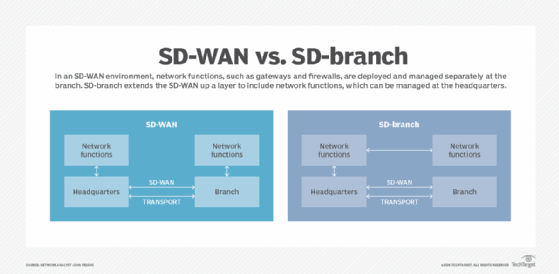What is an SD-branch?
An SD-branch is a single, automated, centrally managed, software-centric platform that replaces or supplements an existing branch network architecture.
Remote or branch offices are critical yet challenging elements for centralized IT organizations. A natural successor in the evolution of software-defined WANs (SD-WANs), SD-branch simplifies the process of branching networks by collapsing multiple network functions onto a single platform. Enterprises typically deploy SD-branch in greenfield locations or as an upgrade or replacement for branch office boxes in smaller branches, such as regional offices, stores, banks or kiosks.
SD-branch components
As branch networking focuses more on application delivery, IT organizations have multiple options for branch routers, including the following:
- Keep the traditional branch router.
- Phase out the branch router in favor of SD-WAN technology, including routing functionality.
- Migrate to an SD-branch service that consolidates network functions into a single platform.
Regardless of the implementation, all SD-branch technology relies upon the following services:
- A virtualized IP services platform that provides cloudlike elasticity, service chaining and programmability.
- A broad set of virtual network functions to deliver extensive networking and security IP services.
- A centralized management framework that enables integrated control, management, analytics and workflow.

SD-branch advantages
SD-branch offers rapid deployment -- such as branch-in-a-box -- lower hardware costs and Opex benefits. Other SD-branch technology benefits include the following:
- Improved operational agility.
- Reduced need for on-site support and maintenance professionals.
- Centralized control of a branch office's network architecture through a single pane of glass.
- Environmental benefits such as a smaller hardware footprint and lower power consumption.
The future of SD-branch
If organizations phase out their existing branch routers in favor of SD-WAN packages, customers will have the option to buy SD-branch services. These services support broader network features, including SD-WAN, routing, security and Wi-Fi. For organizations that choose managed SD-WAN, the service provider will define the options.







